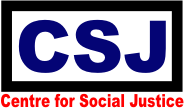CSJ Needs Facilitators
-
October 17, 2019
- Posted by: Center for Social Justice
No Comments
CSJ needs facilitators to conduct training on innovation and social entrepreneurship. Send CV or profile of company to censoj@gmail.com. The draft curriculum is reproduced below.
SOCIAL ENTREPRENERSHIP AND INNOVATION CURRICULUM
Understanding Social Entrepreneurship
- What is social entrepreneurship?
- Who is a social entrepreneur?
- History of social entrepreneurship
- Different types of social entrepreneurship
- Key characteristics of social entrepreneurship
- Defining qualities of social entrepreneurship including principles of social business
- Challenges in social entrepreneurship
- Social capital – definition, groups and networks, trust and solidarity, collective action and cooperation, social cohesion and inclusion, information and communication
- Social innovation – creating social markets, niches, etc.
- Key take-aways
Introducing Innovation, How Social Change Happens & Skills for Innovation
- What is innovation – key defining characteristics; products, processes, services, technologies, business models, etc.
- Steps in innovation – how social change happens
- Skills for innovation
- The idea of disruptive innovation
- Innovating for social change – translating frustration, fears, marginalization and challenges into new vehicles for change
- Issues around efficiency, productivity, quality, competitiveness, etc.
- Indicators and indices for measurement and ranking of innovation
Design Thinking and Human Centred Design Process
- What is Design Thinking and how relevant is it to modern problem solving?
- Human centred design thinking- creative approach to problem solving, purpose built to solve challenges of the social niche/population in focus, tailor made solutions; inspiration, ideation and implementation. who will be using this product? In what context (time, place, device, etc.) will it most likely happen?
- The stages and processes of Design Thinking- iterative, flexible and focused on collaboration between designers and users, with an emphasis on bringing ideas to life based on how real users think, feel and behave; tools and examples.
- Empathise – understanding the human need involved, real need, gaining new insights, the perpetual loop, etc.
- Define- determine the root cause of a problem, meaningful and actionable problem statement which the Design Thinker will focus on solving.
- Ideate – process of generating ideas and solutions through sketching, prototyping, brainstorming, brainwriting, worst possible scenario, research, etc.
- Prototype- producing an early inexpensive, scaled down version of the new idea, revisions
- Test and launch – continual validation
- Conclusions
Wicked Problems
- Definitions
- Characteristics- why are they wicked
- Examples of wicked problems in healthcare, poverty, etc.
- Wicked problems as symptoms of a more deeper problem
- Solving wicked problems- collaboration, multi-disciplinary research and interventions, etc.
Violent Extremism and Social Change
- Framing the question/challenge
- Issues in violent extremism and what fuels it in the NE
- VE and social change innovation
- Ideas for innovation and change
- Conclusions
Innovative solutions to resolving social, cultural and environmental conflicts in the North East (NE)
- Formulation of social, cultural and environmental challenges- framing the challenge
- Context and backgrounds to challenges
- Are these challenges new? What can we learn from other societies?
- Employment and environmental challenges in context
- Ideas for change – throwing up several scenarios for change
- Settling down on options
- Way forward
Local problems and local solutions
- Mapping local problems
- Understanding existing capacities, competencies, coping mechanisms
- Understanding local contexts and resilience
- Synthesis of problem solving with home grown solutions
Concept Development and Brainstorming
- What is concept development?
- Why is concept development important?
- Stages and processes of concept development
- Identification of who, what, where, when, why, and how of the concept and the associated challenge. Developing specific questions to address broader issues, such as: What are the current deficiencies and gaps? What are the external constraints? What are the real-world performance drivers? What are the operational, security, and support concepts? Is it feasible technically, economically, and in a timely manner? What are the associated external and interfacing activities? What happens if any of these questions cannot be answered?
- Critical nature of brainstorming
- Highlights of effective brainstorming for problem solving
- Conclusions and moving forward
